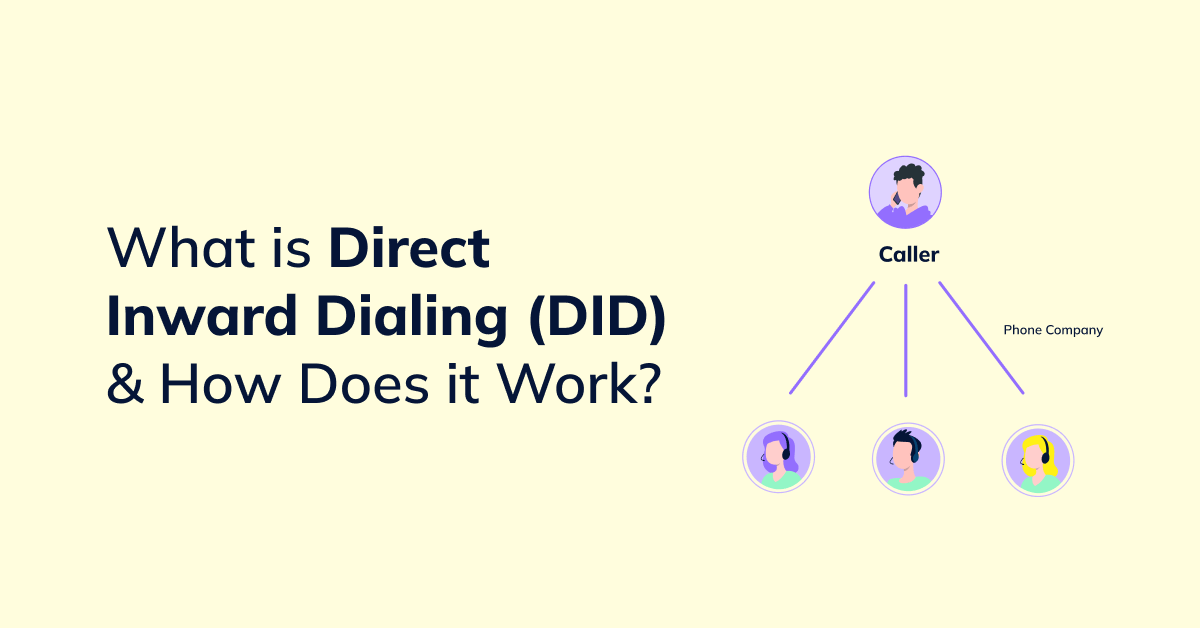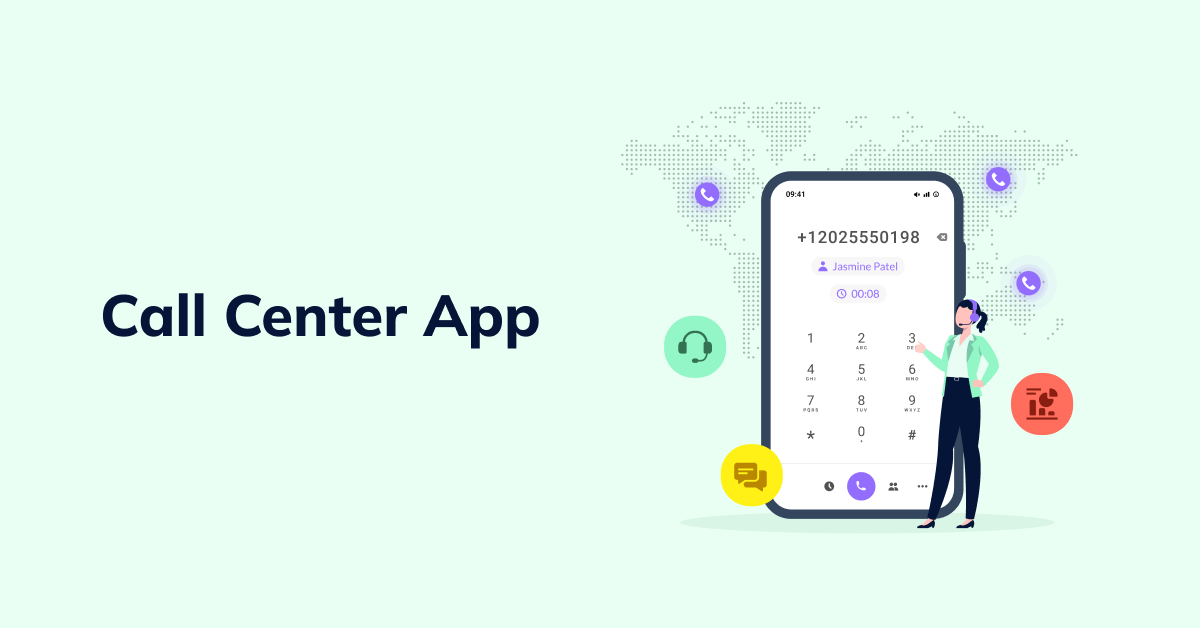Direct Inward Dialing is a valuable telecommunications feature of a business phone system. Thanks to Direct Inward Dialing, businesses can empower their customers with a quick and convenient way to reach specific departments or people within the company through a DID phone number without having to go through a long series of automated IVR menu options or human receptionists. Using Direct Inward Dialing service is one of the ways for call centers to improve customer service experience and reduce support costs.
What is Direct Inward Dialing?
Direct Inward Dialing (DID), also known as Direct Dial-In (DDI), is a phone system feature that enables businesses to connect inbound calls directly with an extension, group of extensions, specific agent, or voicemail. You can leverage Direct Inward Dialing by leasing virtual business phone numbers from a service provider and assigning these numbers to particular agents, ring groups, or queues.
For inbound callers, it means they can simply dial the Direct Inward Dial phone number to reach a person in your company instead of going through your main reception line or lengthy menus in your IVR system. This is particularly helpful when callers already know the department, extension, or agent they want to dial.
Direct Inward Dialing (DID) vs. Direct Outward Dialing (DOD)
While Direct Inward Dialing (DID) is about connecting inbound callers to the desired destination within the company’s phone system – Direct Outward Dialing (DOD) is the opposite feature related to outbound calling. Direct Outward Dialing allows users within a company’s business phone system to make outbound calls outside of their PBX system without having to use the help of an operator or attendant.
What is a DID Number?
A Direct Dial number, or a DID number, is basically any business phone number that directs inbound callers to an extension or user within the company’s phone network, bypassing self-service call routing systems and IVR menus. DID numbers are offered by both cloud-based VoIP phone system providers and traditional landline PBX providers. Direct Dial numbers can be associated with local, toll-free, or premium-rate numbers.
With a cloud-based VoIP service provider, you can purchase virtual DID numbers from anywhere in the world to support your global business communications. From the customer’s perspective, a Direct Dialing number looks just like a standard phone number.
How Does Direct Inward Dialing Work?
When a customer calls a Direct Dial number to reach a user or extension, the phone system provider routes this incoming call either via a landline-wired PRI (Primary Rate Interface) or a cloud-based VoIP system. The method of DID’s data transmission is based on your company’s phone system type, whether it’s a traditional Public-Switched Telephone Network (PTSN), an IP PBX system, or a cloud-hosted VoIP phone system.
Direct Dialing with PSTN
To set up a DID service with a traditional landline phone system, you need to lease and install copper wires known as PRI (Primary Rate Interface) trunks from a telephone company. Unlike virtual SIP trunks, PRI trunk lines route analog call data through your on-premises PBX system. With a landline phone system, however, you are limited to only using local DID numbers and onsite phone system routing. Moreover, you can only have no more than 23 agents handling calls simultaneously. That may lead to more missed calls and longer hold times for callers.
Direct Inward Dialing with IP PBX
In the case of IP PBX systems, when a user makes an inbound call, your VoIP provider transmits the digital data to your company’s PBX (Private Branch Exchange), which then uses the internet to wirelessly transmit the incoming call to the required user or extension. It works the same way with cloud-hosted PBX; however, you would still need to maintain your on-premises PBX, which requires money and effort.
Direct Inward Dialing with cloud-based VoIP
With a cloud-based VoIP phone system, your VoIP provider handles the SIP trunking required to receive inbound calls and routes them to the appropriate Direct Dial number. Today, it’s the most modern and flexible way to employ Direct Inward Dial numbers. Unlike PBX, which requires you to allocate new phone lines – with VoIP, getting new DID phone numbers is much faster and easier, and you can often get it done within the same day. Besides the increased flexibility and scalability – with VoIP, your team can manage an unlimited number of calls at once.
Key Benefits of Direct Inward Dialing
These are some more specific benefits of using Direct Inward Dialing numbers in your call center.
Cost efficiency
Cost efficiency is one of the main benefits of Direct Inward Dialing. With Direct Inward Dialing service, you can save costs by reducing the number of trunk lines required for your business communications and eliminating the need to have a separate physical phone line for every employee. You can also save on long-distance charges by purchasing local and toll-free numbers from your VoIP provider.
Better flexibility and scalability
Another significant advantage of Direct Inward Dialing is the flexibility it offers to businesses. You can purchase DID numbers from all around the world and assign them to your agents, no matter where they are located. Purchasing multiple numbers is as easy as purchasing one – and you can often do it alone or simply by contacting your VoIP call center provider. Besides that, by setting call forwarding, you can forward calls to a different number or multiple numbers at the same time or even mobile phones.
Improved customer experience
With DID numbers, your customers can reach the department, extension, or particular agent they need directly without having to deal with complicated IVR phone menus, which can create a frustrating experience. It saves them time and effort, improving the overall experience of interacting with your business. It also simplifies the follow-up process for your customers, allowing them to reach a particular employee if they have a separate DID number assigned to them.
More personalized customer service
In addition to the previous point, using Direct Dial numbers can help you deliver more personalized support. E.g., you can provide your high-priority customers with a dedicated DID number and empower them to bypass your general call routing system and reach out to an agent directly, showing that your company truly prioritizes their needs.
Enhanced employee experience
Direct Dial service improves the experience for your employees, too. By providing separate DID numbers to specific customer segments (e.g., based on location or language) or having specific DIDs for different departments or agent groups, you can ensure that your agents will always deal with customers they are best suited to support without having to transfer customer calls back and forth. That can save your reps much time and effort.
Easier internal team communication
Furthermore, from your team’s perspective, Direct Inward Dialing helps simplify internal communication between employees within your company. With DID numbers, your team members can call each other via a dedicated extension without having to call your main company line and then go through the directory. This way, you enable your team members to easily communicate even if they are located in different buildings or, even more, in different countries.
Marketing campaign tracking
Direct Inward Dialing can also help you track the efficiency of your inbound marketing campaigns. You can assign unique DID numbers to each marketing campaign and track incoming calls coming to those numbers. Then, you can easily determine which campaign performs better. Similarly, you can assign specific DID numbers to your marketing campaigns on different channels, helping you figure out which channel generates the best ROI.
How to Get DID Numbers
You can obtain DID numbers from a VoIP call center software provider such as VoiceSpin. If you already have your business phone number, you can port it and acquire additional DID phone numbers in 160+ countries to support your global customer communications. You can then activate and deactivate these DID numbers and assign them to your agents, ring groups, or call queues to ensure customer calls always reach the right destination within your company’s phone system.
What You Get with VoiceSpin Beyond Global DID Numbers
Call routing and IVR
VoiceSpin’s virtual call center software offers multiple call routing options and allows you to customize the call routing rules based on your requirements. You can also set up multi-level IVR menus to capture customer intent to route inbound calls to the most relevant departments or agents more effectively. That ensures agents will always handle requests they are best suited for. Efficient call routing can help you improve First Call Resolution rates, reduce the Average Handle Times, and increase Customer Satisfaction (CSAT) scores.
Queue callbacks
Long hold times often become a major source of frustration for customers seeking to get quick support. By setting a queue callback feature, you can enable your callers to opt for receiving a call when they reach the front of the call queue without having to wait on hold until an agent becomes available. That can help you improve the experience for callers and lower the number of abandoned calls. Queue callback is a particularly valuable feature for inbound call centers with typically high call volumes.
Call recording
With automatic call recording, you can record your inbound customer calls for various purposes, including compliance adherence, team’s performance assessment, and agent training. By reviewing recordings of past calls, managers can gain deeper insights into customer interactions, spot improvement opportunities, and enhance agent training and coaching. With the unlimited storage capacity offered by VoiceSpin, your call recordings will be securely stored in the cloud for as long as you need.
Real-time call monitoring
With real-time call monitoring, call center managers or supervisors can hop on live calls to better understand how well agents handle customer requests and where they might need additional training. Moreover, with a call whispering feature, they can provide guidance to agents on call without the customer on the other side hearing anything. This feature is often used during the onboarding process, helping managers get new hires up to speed faster and more efficiently.
Local Caller ID
For outbound call centers, local caller ID is the key to improving the efficiency of outbound calling campaigns. With VoiceSpin, you can easily enable local presence dialing in your auto dialer settings and choose to show local phone numbers when calling your prospects or customers. Research shows that people are four times more likely to accept calls from unknown numbers if they see a local area code on caller ID. That means your sales reps will be able to reach out to more prospects, increasing the efficiency of their outbound calling efforts.
Reporting and analytics
Reporting and analytics features allow you to measure your call center performance and the efficiency of your operations by tracking your most critical metrics and KPIs. You can leverage pre-built reports or generate custom reports to track just about anything. With relevant data at hand, you can make more informed decisions and targeted improvements to ensure your call center operates at its highest potential. In addition, by integrating AI Speech Analyzer, you can get even deeper insights into every interaction.



